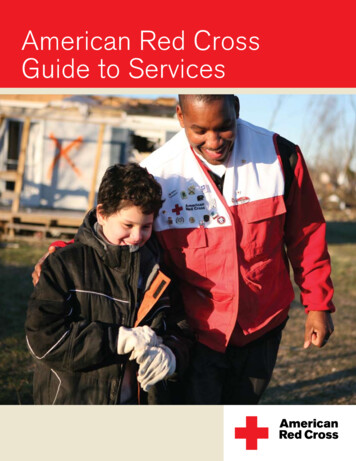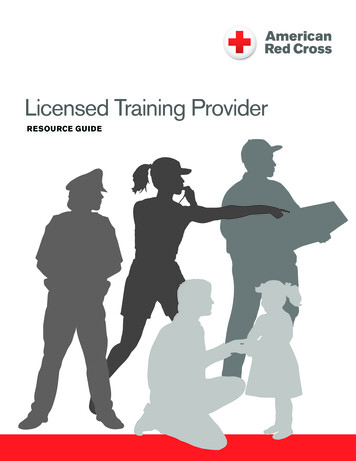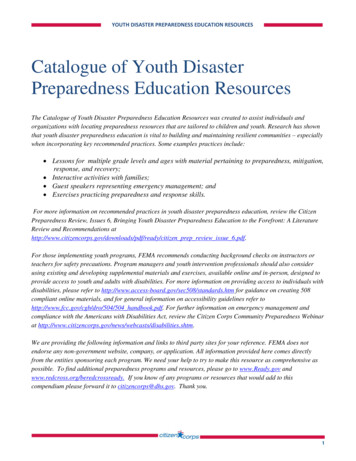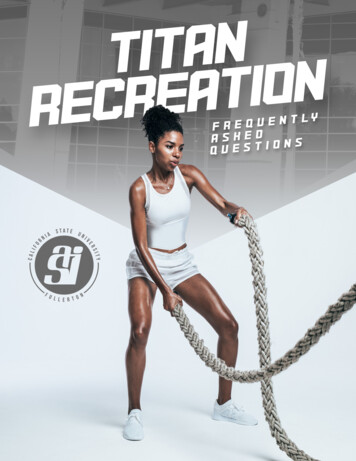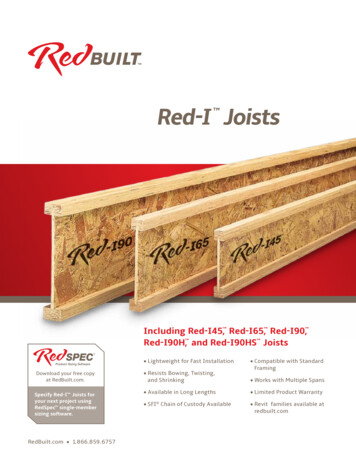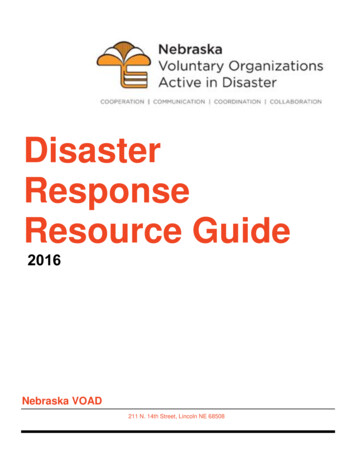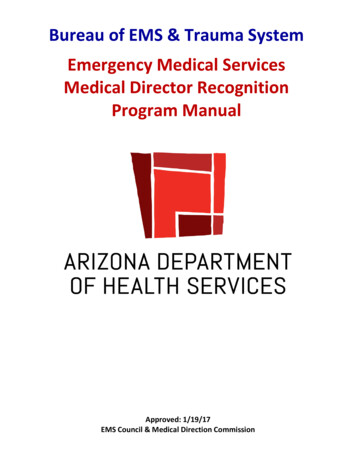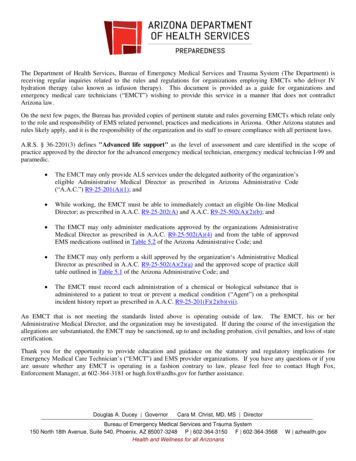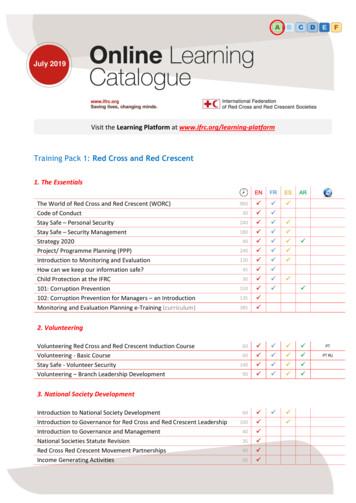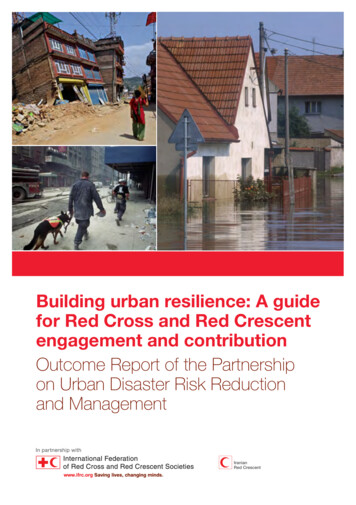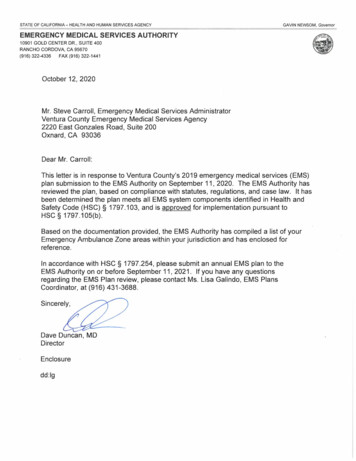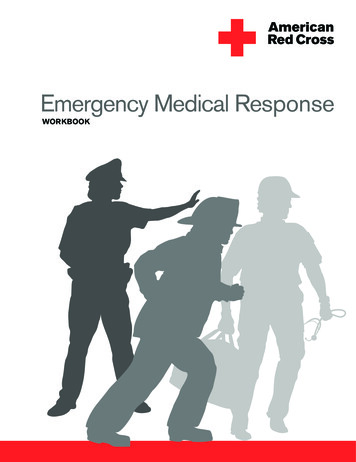
Transcription
Emergency Medical ResponseWORKBOOK
ContentsUNIT 1PREPARATORY2Chapter 1The Emergency MedicalResponder6Chapter 2The Well-Being of theEmergency MedicalResponder12Chapter 3Medical, Legal and EthicalIssues17Chapter 4The Human Body22Chapter 5Lifting and Moving PatientsUNIT 290Chapter 16 Environmental Emergencies96Chapter 17 Behavioral EmergenciesUNIT 6TRAUMA EMERGENCIES102 Chapter 18 Shock105 Chapter 19 Bleeding and Trauma110 Chapter 20 Soft Tissue Injuries114 Chapter 21 Injuries to the Chest,Abdomen and Genitalia118 Chapter 22 Injuries to Muscles, Bonesand JointsASSESSMENT123 Chapter 23 Injuries to the Head, Neck28Chapter 6Scene Size-Up34Chapter 7Primary Assessment40Chapter 8History Taking and SecondaryAssessmentUNIT 7Communication andDocumentation134 Chapter 25 Pediatrics47and SpineChapter 9SPECIAL POPULATIONS130 Chapter 24 Childbirth138 Chapter 26 Geriatrics and Special NeedsUNIT 3PatientsAIRWAY52Chapter 10 Airway and VentilationUNIT 858Chapter 11 Airway Management144 Chapter 27 EMS Support and Operations63Chapter 12 Emergency Oxygen149 Chapter 28 Access and ExtricationUNIT 470CIRCULATIONChapter 13 Circulation and CardiacEmergenciesEMS OPERATIONS153 Chapter 29 Hazardous MaterialsEmergencies157 Chapter 30 Incident Command andMultiple-Casualty IncidentsUNIT 5MEDICAL EMERGENCIES78Chapter 14 Medical Emergencies84Chapter 15 Poisoning162 Chapter 31 Response to Disasters andTerrorism167 Chapter 32 Special OperationsContentsiii
171 CHAPTER ANSWER KEYSEND-OF-UNIT EXAMS249 Unit 1 Preparatory256 Unit 2 Assessment282 Unit 7 Special Populations287 Unit 8 EMS Operations294 End-of-Unit Exam Answer Keys262 Unit 3 Airway327 COURSE REVIEW EXAM266 Unit 4 Circulation347 Course Review Exam Answer Key268 Unit 5 Medical Emergenciesiv274 Unit 6 Trauma EmergenciesEmergency Medical Response Workbook
13Circulation andCardiac Emergencies REVIEW OF CONCEPTS AND TERMS Crossword PuzzleDirections: Complete the crossword puzzle usingthe clues.1234567970810Emergency Medical Response Workbook
DOWN1 A disturbance in the regular beating ofthe heart2 High blood pressure6 Fatty substance found in animal products7 Conditions or behaviors that increase thechance that a person will develop a disease8 Electrical shock to disrupt the heart’selectrical activityACROSS3 Device implanted under the skin to regulatethe heartbeat4 Condition in which the heart stops beatingor beats too ineffectively to circulate blood5 A test that measures and records the heart’selectrical activity9 Absence of electrical activity in the heart10 Delivery of blood to body cells for gas,nutrient and waste exchangeShort AnswerDirections: Supply the information requested.1. Explain ventricular fibrillation (V-fib).5. Trace the path of an electrical impulse inthe heart.6. Describe the major sign of a heart attack.2. Describe CPR.3. List three situations in which you can stopCPR.7. Identify the four links in the Cardiac Chainof Survival.4. Name the two most common conditionscaused by cardiovascular disease.8. Explain how automated external defibrillators(AEDs) function.Chapter 13 : Circulation and Cardiac Emergencies71
CASE STUDY Directions: Read the case studies and answer thequestions that follow.Scenario AYou are called to the scene of a drowning at a nearbylake. A 10-year-old child has just been removed from thewater after being submerged for about 3 or 4 minutes.Your primary assessment reveals that the child is notbreathing and has no pulse.1. You are preparing to perform chestcompressions. Where do you place yourhands to be most effective?a. Uppermost portion of the sternumb. Atop the xiphoid process at the lowersternumc. In the middle of the chestd. Directly over the nipple area2. You would compress the child’s chest towhich depth?a. About 1 inchb. About 1½ inchesc. About 2 inchesd. At least 2½ inches3. Which of the following is most importantfor you to do when performing chestcompressions on the child?a. Keeping the elbows flexed with eachcompressionb. Pausing in between the up and downmotionc. Rocking back and forth as youcompress the chestd. Allowing the chest to recoil fully aftereach compression72Emergency Medical Response Workbook4. An AED becomes available, and youprepare to use it. Which of the following ismost important for you to do before using itwith this child?a. Correctly placing the pads on thechild’s chestb. Ensuring that the child is not lying in apuddle of waterc. Using pediatric defibrillation pads ifavailabled. Checking to see if spare batteriesare includedScenario BYou arrive at an office building in response to a callabout an employee who suddenly started complaining ofchest pain. The patient also is complaining of shortnessof breath and feeling sick to his stomach.1. You obtain a SAMPLE history from thepatient. Which of the following suggeststhat the patient is experiencing a heartattack? Select all that apply.a. The pain is described as squeezing andunrelieved by rest.b. The pain does not radiate.c. The patient has a history ofhypertension.d. The patient is sitting up and leaningforward.e. The patient complains of feeling dizzy.f. The patient’s face is flushed.2. As the emergency medical responder (EMR) onthe scene, which of the following would youdo first if you suspect that the patient ishaving a heart attack?a. Get the patient to stop any activity andrest.b. Summon more advanced medicalpersonnel.c. Closely monitor the patient’s vital signs.d. Begin CPR.
3. Your local protocol allows you toadminister medication to the patient.After asking the patient about the useof medications, you determine that it issafe to administer it. You would administerwhich of the following?a. 1 chewable baby aspirinb A single dose of acetaminophen(Tylenol )c. Two tablets of ibuprofen (Motrin )d. One 5-grain adult aspirin tabletScenario CYou are on the scene of an apartment fire and are caringfor a 6-month-old infant. After opening the infant’sairway, you find that she is not breathing and doesnot have a pulse. You immediately give 2 ventilations,noting that the chest rises and falls, and you quicklyscan for severe bleeding.1. Which action would you do next?a. Begin chest compressions.b. Deliver 5 back blows.c. Give ventilations.d. Do a finger sweep.2. You determine that the infant needs chestcompressions. Which of the followingwould you use to perform chestcompressions?a. The heel of your handb. Two fi ngers of one handc. Thumb side of your fistd. Both thumbs3. Another EMR arrives on the scene to assistyou with CPR. The cycle of compressionsand ventilations that you would perform is—a. 30 compressions and 2 ventilations.b. 15 compressions and 1 ventilation.c. 15 compressions and 2 ventilations.d. 30 compressions and 1 ventilation. SELF-ASSESSMENT Directions: Answer the questions by selecting thecorrect letter(s).1. Which of the following is the most commontype of abnormal cardiac rhythm?a. Atrial fibrillationb. Sinus rhythmc. Ventricular tachycardia (V-tach)d. Ventricular fibrillation (V-fib)2. You are assessing a child who hasexperienced a cardiac arrest. Youunderstand that this is most likely theresult of—a. Drowning.b. Breathing problems.c. Motor-vehicle injury.d. Poisoning.3. You are the only EMR present and areperforming CPR. Where would youposition yourself to give chest compressions?a. At the patient’s headb. Between the patient’s legsc. Even with the patient’s shouldersd. On the patient’s side at the chest4. You have been performing CPR on apatient and the patient begins to breathe.You also note a pulse. Which action is mostappropriate?a. Cancel the call for more advancedmedical personnel.b. Stop chest compressions but continueventilations.c. Continue to monitor the patient whilemaintaining an open airway.d. Obtain an AED to check the heartrhythm.Chapter 13 : Circulation and Cardiac Emergencies73
5. To use an AED, which of the followingmust be present? Select all that apply.a. Absence of a pulseb. Obstructed airwayc. No evidence of the chest risingand fallingd. Pale or ashen skine. Lack of responsiveness6. You are applying AED pads to a child andnotice that the pads may touch each other.Which action is most appropriate?a. Cut one of the pads in half, using a halfinstead of the whole.b. Use just one pad instead of both pads.c. Put one pad on the chest and the otherpad on the back between the shoulderblades.d. Use both pads on the chest, overlappingthe edges of the pads.7. Which structure in the heart is responsiblefor initiating an electrical impulse?a. Atrioventricular (AV) nodeb. Sinoatrial (SA) nodec. Right atriumd. Left ventricle8. Which of the following would you leastexpect to find when assessing an older adultwho may be having a heart attack?a. Shoulder achesb. Indigestionc. Fatigued. Chest pain9. You are called to a patient’s home becausethe patient is complaining of chest pain.Which of the following would lead you tosuspect that the patient is experiencingangina and not a heart attack?a. Pain spreading to the jaw and neckb. Pain that eases with restingc. Pain that is persistentd. Pain accompanied by difficultybreathing74Emergency Medical Response Workbook10. You and another EMR are performingtwo-rescuer CPR. You would expect toswitch positions approximately every—a. 2 minutes.b. 4 minutes.c. 6 minutes.d. 8 minutes.11. You arrive on the scene where anotherEMR is performing CPR on a patient.Which of the following would you do first?a. Call for a position change at the end ofthe last compression cycleb. Immediately begin giving ventilationsto the patientc. Confirm if more advanced medicalpersonnel have been calledd. Obtain an AED, if available12. An AED has delivered a shock to thepatient. Which of the following wouldyou do next?a. Wait for the device to re-analyze theheart rhythm.b. Continue to monitor the patient’scondition.c. Place the patient in a face-up positionwhile maintaining an open airway.d. Begin performing CPR for about2 minutes.13. When interviewing a patient who iscomplaining of chest pain, which questionis most appropriate to ask initially?a. “Have you ever had this type ofpain before?”b. “Can you tell me how you feelright now?”c. “Does the pain move or spreadanywhere?”d. “Is the pain crushing or squeezing?”
14. Which of the following statements bestreflects the experience of a heart attack ina woman?a. Women often report their symptomsearlier than men.b. Women rarely experience shortnessof breath.c. Chest pain in women typically issudden and short-lived.d. Like men, women commonlyexperience chest pain as themain complaint.15. You are preparing to apply AED pads to apatient’s chest when you notice atransdermal medication patch. Youshould—a. Place the pads directly over themedication patch.b. Move the medication patch to anotherarea on the chest.c. Remove the medication patch with agloved hand.d. Apply the pads to a chest area awayfrom the patch. SELF-ASSESSMENT: ENRICHMENT Preventing Coronary HeartDiseaseDirections: Answer the questions by selecting thecorrect letter(s).1. Which of the following statements aboutcoronary heart disease (CHD) is the mostaccurate?a. CHD develops suddenly, leading to adecreased oxygen supply to the heart.b. CHD ranks second as the cause ofdeath in adults in the United States.c. CHD involves arterial narrowing dueto a buildup of fatty substances.d. CHD is primarily linked to geneticsand family history.2. Which of the following risk factors forCHD is a person unable to change?a. Dietb. Ethnicityc. Obesityd. Activity level3. Which of the following is appropriate to doto control the risk factors for CHD? Selectall that apply.a. Increase the intake of fast foods.b. Participate in a regular exerciseprogram.c. Eat foods that are high in animal fats.d. Avoid cigarette smoking.e. Maintain blood pressure control. SKILL SHEETS Refer to the Emergency Medical Response textbook for the following skill sheets for this chapter: CPR—Adult and Child, pages 312–313CPR—Infant, page 314Two-Rescuer CPR—Adult and Child, pages 315–316Two-Rescuer CPR—Infant, pages 317–318AED—Adult, Child and Infant, pages 319–321Chapter 13 : Circulation and Cardiac Emergencies75
Contents iii Contents UNIT 1 PREPARATORY 2 Chapter 1 The Emergency Medical Responder 6 Chapter 2 The Well-Being of the Emergency Medical Responder 12 Chapter 3 Medical, Legal and Ethical Issues 17 Chapter 4 The Human Body 22 Chapter 5 Lifting and Moving Patients UNIT 2 ASSESSMENT 28 Chapter 6 Scene Size-Up 34 Chapter 7 Primary Assessment 40 Chapter 8 History Taking and Secondary
